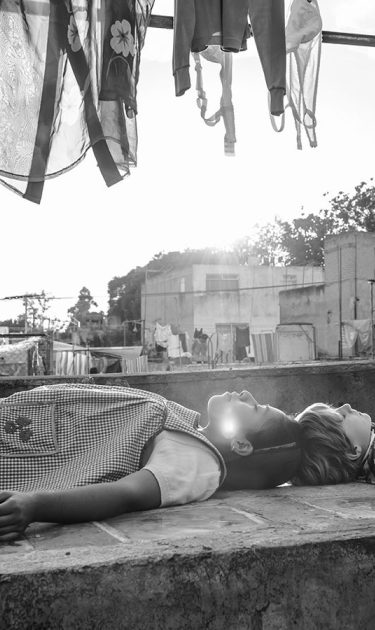Alfonso Cuarón’s Roma is a gift to Mexico. That’s how actress Marina de Tavira put it when we sat down to talk about the black-and-white movie that had just screened as part of the New York Film Festival. “This is Alfonso’s gift to Mexico. Loving his country and giving a voice, light, and a look at women who tend to be taken for granted. Who tend to be invisible and who make a hell of a difference in a lot of families, at times sacrificing their own families, their own land.”
De Tavira plays Sra. Sofía, the head of a middle-class household in 1970s Mexico City. Sofía gets help raising her three kids and managing her two-story house in Colonia Roma from domestic worker Cleo, played by newcomer (and now Gotham Award nominee) Yalitza Aparicio. Bucking convention, Roma chooses to focus on Cleo and her experiences rather than the family drama and Sofía’s own marital woes. It follows Cleo’s housework. Her late-night workouts. Her Sunday outings. The quiet life she leads on the margins of this family and the seismic cultural shifts taking place around her. Appropriately, the film is dedicated to Libo, Cuarón’s own Cleo while growing up.
Even as it marks his return to Spanish-language fare, the Mexican director has brought to bear everything he’s learned while shooting movies like Children of Men and Gravity. The long takes that characterized those films, which felt exacting and formally dazzling, are deployed here as a way to mark the slow passage of time. More than shooting a movie, Cuarón wanted to recreate the feel of real life. That meant even his audition process was anything but traditional. Aparicio, who only went to large casting call in Oaxaca at the behest of her sister, didn’t think much of the fact that she was asked about her life: “What do you do? What do you like? Do you believe in God? Have you fallen in love?” There were no line readings. No “acting.” Cuarón’s casting directors were looking to really get to know these women.
For de Tavira, this was a change of pace from her usual work on screen and on stage. Not that this dissuaded her from auditioning, even if she only found out it was a Cuarón project until the day she heard she got the part. “From the beginning, he told us that this film was going to be about life. I knew it would be about all those small moments: the meals, the family dynamics, things that can seem very mundane, but that he made into something quite epic.”

Rather than give his actors a completed script, he gave them sketches of the scenes and specific instructions for what was to be said and done. He didn’t let them know what would be happening two or three scenes ahead — not even what or how other actors in the same scene would react. “I kept thinking about the shoot as if it were my own life,” Aparicio shared. “I said, well, there’s no set script on my life, so it’s just about letting things happen as they come.” As Cleo, she just focused on the tasks at hand, like in the film’s long opening sequence where we see her washing the tiled floor of the house’s garage and open spaces.
The one aspect that made playing Cleo accurately a challenge was the amount of Mixteco that Cuarón wanted to incorporate into her character’s dialogue. Unfortunately, Aparicio’s community has all but lost Mixteco and she’s not quite fluent in it. Her fellow actress Nancy García García, who plays another housekeeper named Adela, was her tutor, patiently working with her so they could go back and forth between Spanish and Mixteco while doing their chores and gossiping about their respective boyfriends. But the experience, and the film’s loving treatment of the communities Cleo and Adela come from, hopefully helps put indigenous languages at the center of what Mexican culture and history can be.
“I hope that, especially, our country gives more importance to all these languages we’re losing,” Aparicio told Remezcla. “At the end of the day that’s our history; it’s our culture. It makes me very sad that parents, out of fear, opt to tell their children not to learn these languages — Nahuatl, Mixteco, Triqui — and to focus on Spanish instead. And I say that as someone who still struggles and stutters with Spanish!”
This interview was translated from Spanish by the writer.




